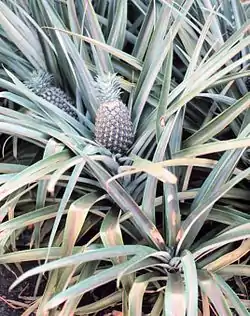鳳梨
Chinese
| male fenghuang | pear | ||
|---|---|---|---|
| trad. (鳳梨) | 鳳 | 梨 | |
| simp. (凤梨) | 凤 | 梨 | |
| Literally: “feng pear”. | |||
Etymology
So named for the similarity between the crown of a pineapple and the tail of a male fenghuang.
Pronunciation
Synonyms
Dialectal synonyms of 菠蘿 (“pineapple”) [map]
Descendants
Japanese
| Kanji in this term | |
|---|---|
| 鳳 | 梨 |
| ほう Jinmeiyō |
り Grade: 4 |
| on’yomi | |
Etymology
From Chinese 鳳梨/凤梨 (fènglí),[1][2] probably more specifically Cantonese, given that it was the Portuguese who first brought this fruit to East Asia, and the Portuguese were more active in southern China.
The pineapple was introduced to Japan relatively recently, with the earliest mentions around 1830.
The reading is the regular Japanese on'yomi (kan'on) for the Chinese spelling. Compare the modern Cantonese reading fung6 lei4.
Usage notes
In modern Japanese, the term パイナップル (painappuru) is much more common.
Synonyms
- パイナップル (painappuru)
References
- 1988, 国語大辞典(新装版) (Kokugo Dai Jiten, Revised Edition) (in Japanese), Tōkyō: Shogakukan
- 2006, 大辞林 (Daijirin), Third Edition (in Japanese), Tōkyō: Sanseidō, →ISBN
This article is issued from Wiktionary. The text is licensed under Creative Commons - Attribution - Sharealike. Additional terms may apply for the media files.
